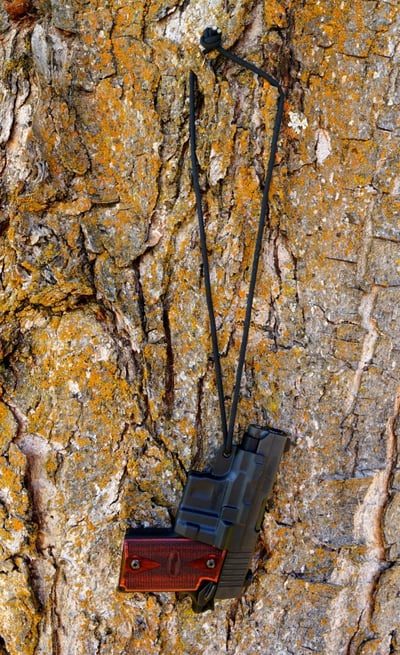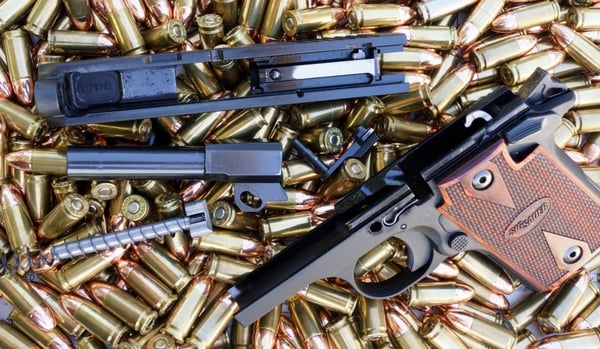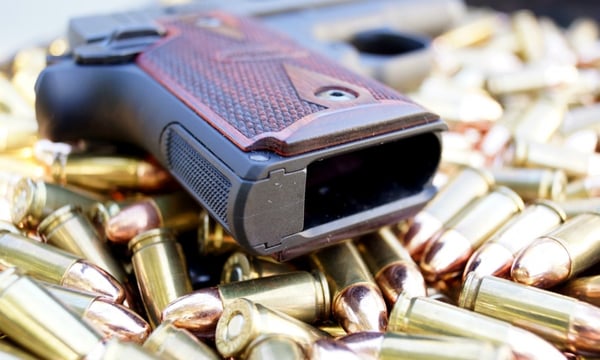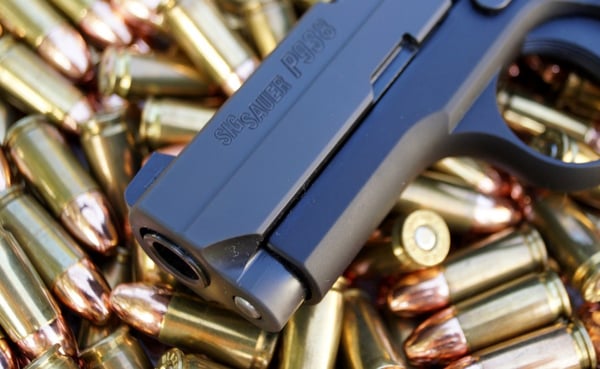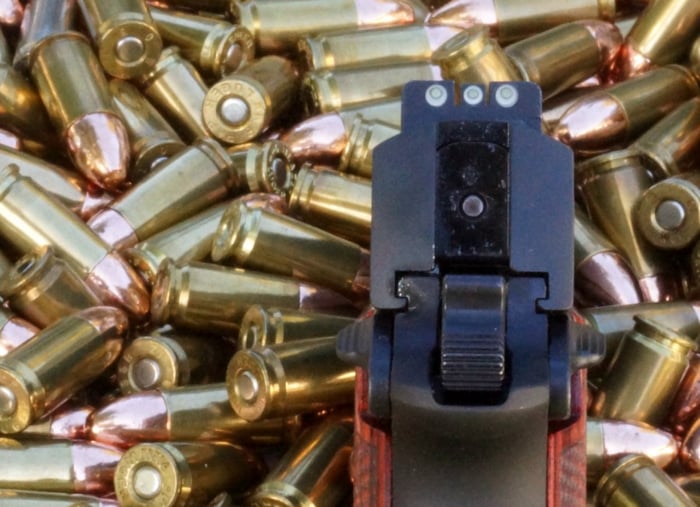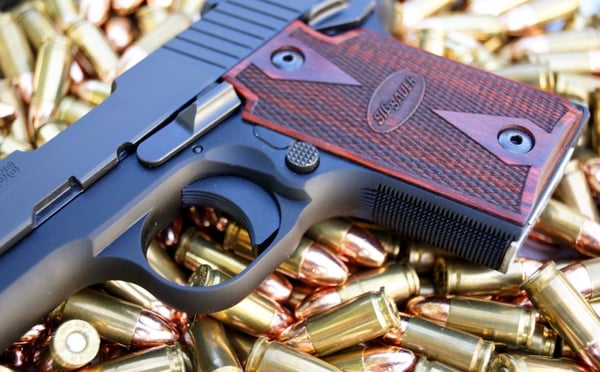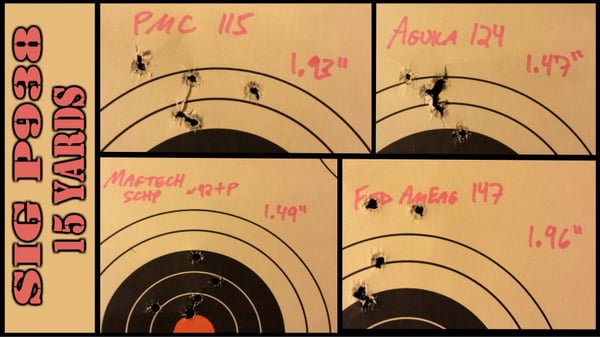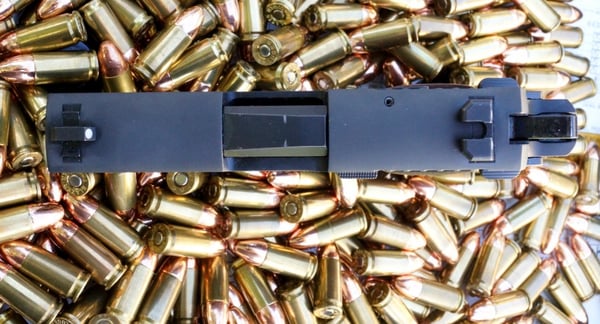Gun Review: SIG SAUER P938
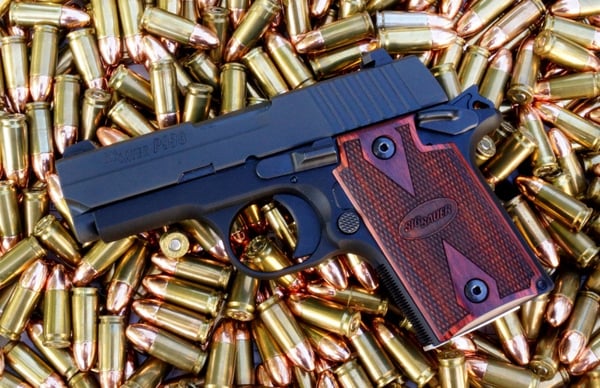
In recent years there has certainly been no shortage of sub-compact, "pocket-sized" 9mm pistols to choose from.
Market demand has spoken, and manufacturers have answered with available products. However, if you're a "cocked & locked," hammer-fired kind of a gal (or guy) you've been almost completely overlooked. Thankfully, one of the only options out there happens to be a pretty good one -- the SIG SAUER P938 . . .
In The Box
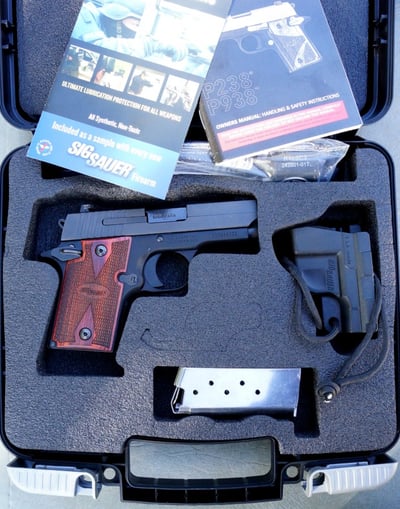 SIG makes at least 10 variations of the P938
SIG makes at least 10 variations of the P938
Holster
NOT A NECK LANYARD... obviously
Let's start with the "holster" just to avoid any confusion and ensuing accidental deaths. While the P938 is an attractive pistol, it is not jewelry and this lanyard is not designed to be a necklace. Wearing it as such positions the muzzle within a foot of your chin, pointing at...your chin. So, not high on the recommended list (okay, maybe as the last item on your bucket list). This is probably obvious to you, but as the intended function of this holster does not seem to be mentioned in the owner's manual or on SIG's website I figured we'd briefly cover it here.
This tiny kydex piece clicks solidly over the trigger guard and ensures that the trigger cannot be depressed by objects in your bag, purse, pocket, waistband, tackle box, glove compartment, desk drawer, etc. The lanyard allows you to anchor the holster -- maybe it's more of a sheath, really -- in said bag or clothing or container, so when the gun is drawn the holster is pulled off and stays behind. Shove the little gat down your pants or into your pocket and tie the lanyard to your belt. Drop it in your "go bag" and affix the lanyard to a handle or other point. Options are limitless, really. Just...you know...maybe not around the neck.
Build
All configurations of the P938 feature a stainless steel slide on an aluminum alloy frame. All are single action only, hammer fired, and sport an ambidextrous thumb safety. While some of the mechanics are different, at a high level the pistol is a miniature 1911.
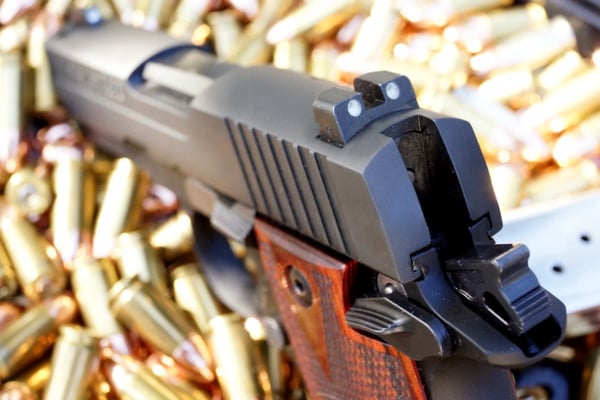
Parts machining, fit, and finish are all good. Solid quality look and feel like you expect from most of SIG's products.
A ball detent provides a tactile click when snicking the safety on or off. It requires specific intent to engage, but disengages easily and naturally with a downward sweep of your thumb. Very familiar to 1911 shooters.
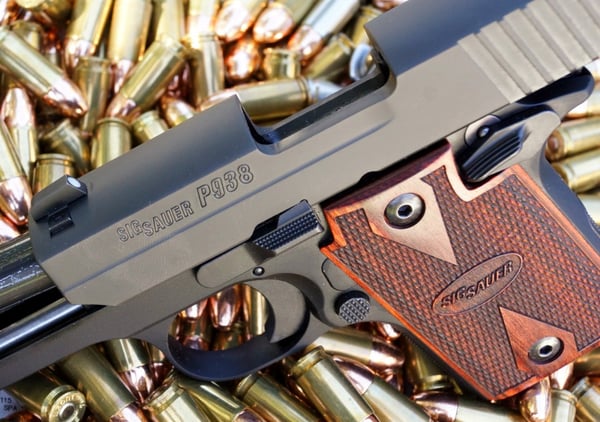
Same familiarity, then, with the magazine release button and the slide stop lever. Not all "microcompact" pistols have their controls in the normal or expected locations, but once again the P938's are in the "right" relative places for those familiar with a 1911 or, for that matter, with the vast majority of pistols.
Takedown is accomplished by pulling the slide back until the disassembly notch lines up with the slide stop properly, and then pushing/pulling the slide stop out of the frame. The slide is now free to slide off the front. Some similarities and some differences from your traditional 1911 design can be seen in the photo below.
One thing I found interesting is that there is no channel in the slide for the ejector -- the ejector is actually spring-loaded and, to allow the slide back onto the frame, you must push and rotate the ejector forwards and down below the back of the slide. Once the slide is over it, the ejector springs back up into position.
A useful departure from the standard 1911 design is that an engaged safety does not lock the slide in place.
This means you can rack the slide -- thereby chambering or ejecting a round -- with the safety on the entire time. The P938 also has a firing pin block safety. Some 1911s have both of these things as well, and an argument could be made that they're desirable features in an everyday carry piece. Typical 1911s do have a grip safety, while the diminutive P938 does not.
Finish
The P938 Rosewood sports a Nitron-coated slide and a black, hard coat anodized frame. Some versions have bare stainless or two-tone slides, and some have nickel accents (slide stop, mag release, safety, mainspring housing pin). The P938 Scorpion is the only model without a black frame, instead rocking a Flat Dark Earth coating on frame and slide. I think it's also the only one with front slide serrations. Grip styles and materials vary across the P938 line.
Sights
SIG's P938 line comes with SIGLITE Tritium night sights dovetailed into the slide. A flat front ledge on the rear sight will allow tactical operator types to manipulate the slide one-handed (hook the rear sight on your belt or other object, and rack away). They're actually the same, normal-sized sights you would find on a P226 and many other SIG models...
...which is actually a small point of contention for me. Take sights designed for a full-size slide and put them on a pocket gun and the distance between them shrinks, which makes the front sight grow in comparison to the rear sight.
Basically, the notch in the P938's rear sight needs to be wider, and if this were my gun I would open it up a bit. There isn't much light on either side of the front blade in the close-up photo above, and when you're actually holding the gun out at arm's length those gaps no longer exist. I know my offhand accuracy suffered a bit because of this, and if it weren't for the nice dot on that front blade I think I'd be all over the place to the left and right.
Magazines
Most P938 variants come with the flush-fitting, stainless steel, 6-round magazine with flat, stainless steel follower seen here. SIG does make a 7-round mag with extended baseplate, and it's included with a few of the P938 models instead. They're both available for about $36 at a retailer. I'm not actually sure if any of the P938 configurations ship with multiple magazines in the box.
Trigger
A curved, serrated trigger rests in the undercut trigger guard. Mechanically it deviates from a 1911's in that it's actually hinged at the top (see pin below slide stop), so it rocks or swings like most modern pistol triggers do rather than pulling straight backwards like a 1911 trigger.
The trigger pull is quite good. Just a bit of slack (aka take-up or pretravel), basically no perceptible creep, and then a crisp break. Reset distance is a bit longer than a decent 1911 (possibly thanks to the firing pin block, which would explain the vast majority of the pretravel), but is still very short compared to the P938's peers. There's just a bit of grit in the trigger's travel, which actually seemed to smooth out as I broke the gun in. The reset is a nice click that you can easily feel. I suppose it really isn't fair to compare the P938's trigger fundamentals to a quality 1911, so gauged against its microcompact peers I'd easily say it's in the top tier.
With that said, a light pull weight doesn't mean "good trigger" to me as it does to some folks, so SIG's spec of 7.5-8.5 lbs sits just fine with me. Especially for a self defense pistol with a short trigger pull. My own testing with a Timney trigger pull gauge had this example coming in between 7 and 7.5 lbs each time, averaging out closer to 7.
Accuracy
Five-shot accuracy groups from a sandbag rest at 15 yards:
On The Range
With only one, 6-round magazine it was a bit of a slow process to really put a lot of lead on target, but I went through over 250 rounds of 115 grain reloads and 50 rounds of various factory ammo ranging in weight from the 92.6 grain Magtech to the 147 grain Federal American Eagle that were both also used in the accuracy testing above. I had no malfunctions of any sort.
The closest thing I could consider even approaching a malfunction is that the bottom of the slide seems to drag particularly hard on the top round in the magazine (and/or the feed lips are particularly slippery). For example, insert a fully-loaded magazine and chamber a round. Pop the magazine out in order to top it off so you can carry the P938 at full 6+1 capacity. Well, when you eject the magazine -- and it may not drop free in this case for the following reason -- the top round is going to be pulled forwards toward the front of the feed lips. It will need to be put back in place before you can load that final round. My H&K P7 does this also, as do a decent number of other unquestionably high quality pistols, but they don't all do it. The workaround would be loading a single round or at least some amount less than 6 into the mag, chambering your one-in-the-hole, then filling the mag the rest of the way. For the record, chambering from the magazine is suggested over dropping a round into the chamber and releasing the slide for safety's sake as well as for extractor preservation. Pistol extractors, with very rare exception, don't actually pop over the rim of the rounds, rather the rim slides up the breech face and under the extractor as the round is moving up into the chamber. The front of the extractor is almost certainly beveled so it's capable of popping over the case rim, but it usually isn't intended to and this can shorten its life or break it outright.
Considering the lilliputian SIG's extremely light weight and the fact that one's pinky finger has no home on it, I found its felt recoil to be pretty comfortable. Even the Magtech +P fireball monsters were surprisingly pleasant to shoot. At first, the safety was drilling me on the strong hand thumb but wrapping it a bit more to the side of my weak hand thumb rather than right over the top cured this. A larger beavertail would prevent the touch of hammer bite I got a couple or few times, but would obviously make the pistol longer as well and potentially less comfortable to carry.
Trigger pull was very nice.
Consistent and repeatable with a clean break is always appreciated. My only gripe here would be slight discomfort in recoil. Despite otherwise softer-than-expected felt recoil as described above, there is some movement and muzzle flip that's hard to avoid with such a light gun, and the bottom of the curved trigger gnawed away at my finger over time. Some combination of the muzzle going up, the trigger curving forwards at the bottom, and the trigger's fairly square edges plus the gap at the front, bottom above the trigger guard. Only a minor annoyance.
On the range, SIG's P938 was combat accurate for me. I don't think I ever missed the hit zone of a torso target at 5 yards, but at 7 or farther when trying to shoot about as quickly as I could get a legitimate sight picture I would wander left or right towards the edges or totally off at longer ranges. Usually left, as the very slim grip and short reach to the trigger tend to slightly screw with my grip and trigger pull fundamentals until I get used to it. However, I'm blaming my just slightly-disappointing left/right accuracy on the sights. Again, I'd open up that rear notch a bit if it were mine.
Conclusions
Overall, the SIG Sauer P938 is more pleasant to shoot than you'd likely expect. I'm sure it would be even better with an extended mag that allows all five fingers to join in on the fun. It's super light, feels like a "real gun," runs reliably, and is one of the easiest-to-conceal 9mms available.
The cost of entry is on the high side, but the quality is commensurate. Where I really think the P938 is worth it is when you're used to shooting a hammer-fired pistol with manual safety -- especially and particularly a 1911. If you compete with a 1911, target shoot with one, carry one when your attire affords it, etc etc, then the P938 is a no-brainer. Same manual of arms in a carry piece or backup gun as your primary or as what you're most used to and trained on? Yes, please.
Specifications: SIG SAUER P938
Caliber: 9x19 (there is a .22 LR variant as well as two 9mm-to-.22 LR conversion kits)
Capacity: 6+1 or 7+1 with extended magazine
Barrel Length: 3.0"
Overall Length: 5.9"
Height: 3.9"
Width: 1.1"
Weight: 16 oz with unloaded magazine
Sights: SIGLITE Night Sights
Grips: Hogue Rosewood (varies by P938 sub-model)
Trigger: Single Action Only. 7.5-8.5 lbs pull weight (7 lbs as tested)
MSRP: Varies depending on configuration
Ratings (Out of Five Stars):
Accuracy: * * *
It's there mechanically, and the rear sight thing is an easy enough fix.
Ergonomics: * * *
I'd say it's par for the course for tiny nines. If you're a huge 1911 fan you'll probably feel more generous here, but it definitely isn't as ergonomic in the grip as, say, an S&W M&P Shield. Also the trigger nitpick.
Reliability: * * * * *
Works out of the box. Fed a variety of ammo including three brands of hollow points and cheap reloads. Zero stoppages. High quality.
Trigger: * * * * 1/2
Very good among pocket pistols.
Customize This: * * * *
Lots of holster options. Some sight, grip, and laser options as well. Swappable grip panels alone put it above the norm. No accessory rail, though.
Overall: * * * *
Okay here's the deal. I personally like some other options a little better, especially for the price. The P938 isn't going to replace my Beretta Nano, which is still my choice in this size category and my EDC. BUT...if my primary were SAO, cocked-and-locked, hammer-fired, and especially if it was a 1911 and/or my experience, training, etc. was on this manual of arms, I'd CCW a P938 in a heartbeat. It would be the choice without question, and it will be my recommendation for anyone who falls into this category (e.g. Nick Leghorn, who CCWs a commander-sized 1911 IIRC).



